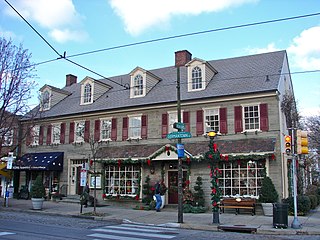James Turrell is an American artist primarily concerned with Light and Space. Turrell was a MacArthur Fellow in 1984. Turrell is best known for his work in progress, Roden Crater, a natural cinder cone crater located outside Flagstaff, Arizona that he is turning into a massive naked-eye observatory.
Conservative Friends refers to members of a certain branch of the Religious Society of Friends (Quakers). In the United States of America, Conservative Friends belong to three Yearly Meetings, Ohio, North Carolina, and Iowa. English Friends affiliated with the Conservative branch tend to use the term Primitive, or Plain. There is no single unifying association of Conservative Friends, unlike three of the other branches of Quakerism in America, represented by Friends United Meeting, Evangelical Friends International, and Friends General Conference.

A Friends meeting house is a meeting house of the Religious Society of Friends (Quakers), where meeting for worship is usually held. Typically Friends meeting houses do not have steeples.
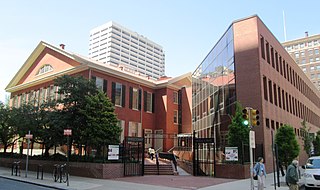
The Race Street Meetinghouse is an historic and still active Quaker meetinghouse at 1515 Cherry Street at the corner of N. 15th Street in the Center City area of Philadelphia, Pennsylvania. The meetinghouse served as the site of the Yearly Meeting of the Hicksite sect of the Religious Society of Friends (Quakers) from 1857 to 1955.

The Nine Partners Meeting House and Cemetery is located at the junction of NY state highway 343 and Church Street, in the village of Millbrook, New York, United States. The meeting house, the third one on the site, was built by a group of Friends ("Quakers") from the Cape Cod region, Nantucket and Rhode Island in 1780.
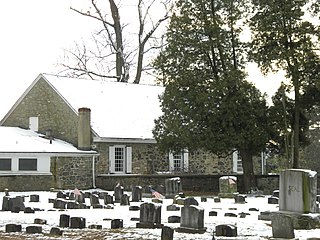
Birmingham Friends Meetinghouse is a historic Quaker meeting house at 1245 Birmingham Road in Birmingham Township, Chester County, Pennsylvania. The current meetinghouse was built in 1763 and added to the National Register in 1971. The building and the adjacent cemetery were near the center of fighting on the afternoon of September 11, 1777 at the Battle of Brandywine. Worship services are held weekly at 10am. The meetinghouse and an adjacent octagonal schoolhouse are listed on the National Register of Historic Places as Birmingham Friends Meetinghouse and School.

Old Kennett Meetinghouse is a historic meeting house of the Religious Society of Friends or "Quakers" in Kennett Township near Chadds Ford, Pennsylvania.

Chichester Friends Meetinghouse is a historic Quaker meeting house at 611 Meetinghouse Road near Boothwyn, in Upper Chichester Township, Delaware County, Pennsylvania. This area, near Chester was one of the earliest areas settled by Quakers in Pennsylvania. The meetinghouse, first built in 1688, then rebuilt after a fire in 1769 reflects this early Quaker heritage. The building was added to the National Register of Historic Places in 1973.
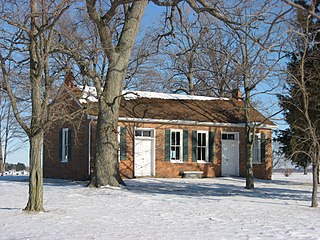
The Green Plain Monthly Meetinghouse is a historic former Quaker house of worship near South Charleston in Clark County, Ohio, United States. Built in 1843, it was used by a part of a monthly meeting that was established in the area in 1822. The original Green Plain Monthly Meeting lasted for only a short while, splitting into Orthodox and Hicksite branches just four years after it was founded: the Orthodox members settled in the community of Selma, while the Hicksites kept the original property. In turn, the Hicksites split in 1843 over the issue of slavery; the liberal party kept the original church, while the conservatives moved to South Charleston-Clifton Road and built the present building.

Appoquinimink Friends Meetinghouse, also known as the Odessa Friends Meetinghouse, is a very small but historic Quaker meetinghouse on Main Street in Odessa, Delaware. It was built in 1785 by David Wilson and added to the National Register of Historic Places in 1972. Members of the meeting, including John Hunn and his cousin John Alston, were active in the Underground Railroad and Harriet Tubman may have hid in the meetinghouse. Measuring about 20 feet (6.1 m) by 22 feet (6.7 m), it may be the smallest brick house of worship in the United States.

Friends Meetinghouse is a historic Quaker meeting house at 4th and West Streets in Wilmington, Delaware in the Quaker Hill neighborhood. The meeting is still active with a membership of about 400 and is part of the Philadelphia Yearly Meeting. It was built in 1815–1817 and added to the National Register of Historic Places in 1976.
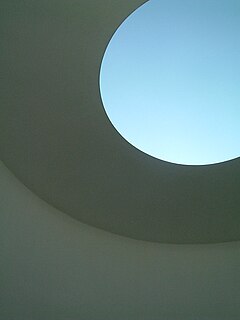
A skyspace is an architectural design in which a room, which is painted in a neutral color has a large hole in its ceiling which opens directly to the sky. The room, whose perimeter has benches, allows observers to look at the sky in such a way as though it were framed. LED lights which surround the hole can change colors to affect the viewer's perception of the sky.

Mercer Street Friends Center is located in Trenton, Mercer County, New Jersey, United States. The building was built in 1858 and was added to the National Register of Historic Places on August 12, 1971. It now houses the main offices of Mercer Street Friends, a Trenton-based Quaker-affiliated social service agency founded in 1958.

Fair Hill Burial Ground is a historic cemetery in the Fairhill neighborhood of Philadelphia, Pennsylvania. Founded by the Religious Society of Friends in 1703, it fell into disuse until the 1840s when it was revived by the Hicksite Quaker community of Philadelphia, which played an important role in the abolition and early women's rights movements. The cemetery is currently operated by the Fair Hill Burial Corporation, which is owned by Quakers and neighborhood community members.
Live Oak Friends Meeting House is a Quaker meeting house located at 1318 West 26th Street in the Heights area of Houston, Texas, United States. The meeting house, which was completed in December 2000, was designed and built to house the Live Oak Friends Meeting, which was formed in 1954. The building features a permanent installation by the artist James Turrell, known as the Skyspace or One Accord. It has been described as an architectural "idealization of Quaker testimonies like peace and equality."

Twelfth Street Meeting House was a Quaker meeting house in Philadelphia, Pennsylvania. It was built on the west side of 12th Street, south of Market Street, 1812–13, incorporating architectural elements from Philadelphia's Great Meeting House (1755).
Many historic Friends meeting houses in Pennsylvania were constructed in colonial times and are listed individually by the National Register of Historic Places (NRHP) and others are contributing buildings in historic districts. Several Friends meetings, the equivalent of church congregations in other denominations, were founded in Pennsylvania by the Religious Society of Friends or Quakers in the early 1680s. Thirty-two extant meeting houses, the equivalent of church buildings, were constructed before 1800. Over 100 meeting houses built before 1900 were documented by the Historic American Buildings Survey in a survey that led to their publication of Silent Witness, Quaker Meeting Houses In The Delaware Valley, 1695 To The Present in 2002.

The Roaring Creek Friends Meeting House is a historic place of worship for members of the Religious Society of Friends, or Quakers, in rural Columbia County, Pennsylvania, near Numidia on Quaker Meeting House Road.

